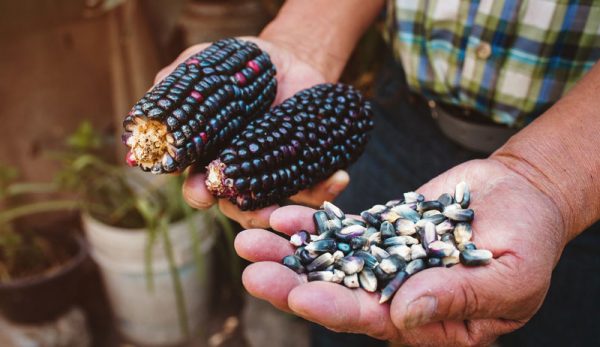
Local sweet corn makes the most reasonable adults turn to giddy children at the farmers market come July in Kentucky. Bought by the bushels for canning and freezing, it seems people can’t get enough until the season ends in September.
Why, then, is the corn we largely subsist on not the same darling of the local food scene? It’s time flint corn, flour corn and dent corn have their day in the spotlight and in your garden.
Storage Corn
There are several types of corn, but largely they’re thought of as sweet corn, popcorn and storage corn. Dent corn, flour corn and flint corn all fall into the storage corn category, with some discernments:
- Dent corn: Dent corn, or field corn, fills most of the 91.7 million corn acres in the US, and most of those acres are planted in genetically modified varieties. This corn is primarily used to feed animals, make processed foods and create ethanol. It has a high starch content and can be ground into fine cornmeal and dried to make hominy or masa.While corn with genetically modified traits dominate the crop scene, plenty of non-GMO seeds make for interesting and worthwhile garden varieties. Native Seeds/SEARCH recommends Mayo Tuxpeño and Día de San Juan varieties.Around here, Kentucky Rainbow and Hickory King are heirloom favorites.
- Flint corn: As implied by the name, flint corn is a hard-shelled type, which is ideal for storage, and therefore also ideal for processed foods. Cornmeal, grits, polenta, and nixtamilzation for hominy and masa are its typical home uses.Native Seeds/SEARCH likes Onaveño and Southern Maíz Blanco. Floriani Red is another to know.
- Flour corn: Flour corn is soft and starchy, so it is ground into very fine cornmeal, or corn flour. This a popular crop in the Southwest.Tohono O’odham 60-Day and the more commonly known Hopi Blue are Native Seeds/SEARCH’s picks. Painted Mountain corn is also a beautiful heirloom variety.
Learn more about popcorn and how you can grow the crop at home.
How to Grow
All corn types start out pretty much the same. You plant a kernel in nitrogen-rich soil, and it grows a stalk. Some of the heirloom varieties will grow to 12 feet and taller. An ear—sometimes as many as three viable ears—grows on each stalk.
The three sisters planting method—corn, beans to run up the corn, and squash to shade out the weeds and maintain soil moisture—is a rewarding home- and community-garden cultivation method.
How to Store
You want your corn to be as dry as possible. Any moisture remaining can cause molding.
Harvest just before first frost, when the husk is papery and dry. Pull back the husks, and hang the corn in bundles. Whatever dry, well-ventilated place you hang your garlic to cure will work for corn!
Test the corn after a couple of weeks. If there’s any give in the kernel, it needs more drying time. If the kernel is solid, you can store the whole cob—husks removed—or shell the corn and store the kernels only.
Either way, keep them in a dry, sealed container, such as a food-safe 5-gallon bucket or 50-gallon drum, to exclude rodents, insects and moisture.
Try this recipe for cheesy grits with leeks!
How to Prepare Storage Corn
For corn to be fully digestible, it requires nixtamalization—a process of boiling and soaking with lime. It’s not an entirely necessary step for cornbread, grits and the like, but it’s something that needs to happen for hominy, tamales, tortillas and other recipes calling for masa.
Geek out on nixtamalization like I did with this article.
If you’re making homegrown ground corn a regular part of your diet, get an inexpensive handheld corn sheller and invest in an electric grain mill. For smaller amounts, you can use a hand-crank grain mill, nice food processor or heavy-duty blender.
For very small amounts, a coffee grinder will do.
Grind the corn as you need it—the oils in the corn will eventually turn. If you grind a batch to keep on hand, store it in the fridge or freezer for freshness.
From here, try your hand at cheesy grits with leeks (above), polenta with sausage and egg, and your favorite cornbread recipe—we’ll save the sweet vs. savory cornbread debate for another time.
When you’re feeling fancy, go for homemade tamales. They take all day, but the end result is satisfying. You’ll find additional interesting dishes from cuisines the world over.
Homegrown and fresh-ground corn—like most things homegrown and freshly prepared—has a distinct fresh flavor that will make all the difference in your cooking. The plants add interest to your garden, and the vibrant colors of heirloom varieties add interest to your plate.




